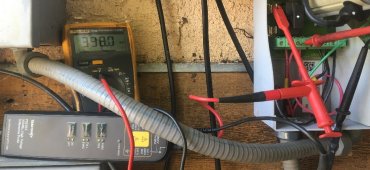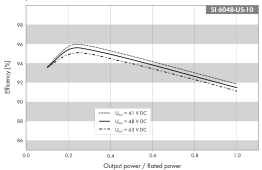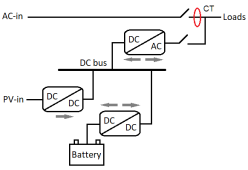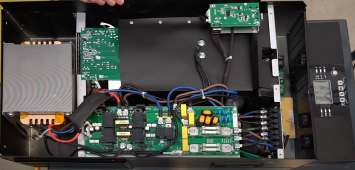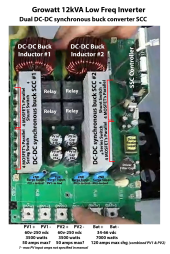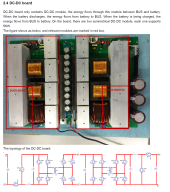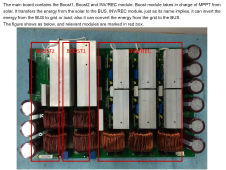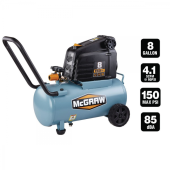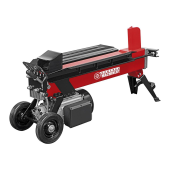Hedges
I See Electromagnetic Fields!
- Joined
- Mar 28, 2020
- Messages
- 21,831
In the interest of science  I have captured waveforms drawn by a high frequency inverter from the battery.
I have captured waveforms drawn by a high frequency inverter from the battery.
This could give some insight to how a BMS might react.
About 25 years ago I found myself with idle hands and some money ($800?) burning a hole in my pocket. I wandered into Quement Electronics in San Jose and walked out with a StatPower PROwatt 2500W inverter (12V battery to 120VAC modified square wave.)
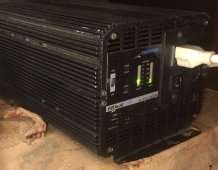
The guts include a bank of transistors and transformers

Instrumented with a DENT current transformer (333 mV/100A) on AC output,
Fluke i2000FLEX 200A, 2000A Rogowski Coil on battery cable (10 Hz to 20 kHz response)

SunXtender 104Ah 12V AGM battery (14 years old, about 40% capacity remaining)

Test Results
The efficiency figure for no-load is bogus, reflects a 30 mA AC draw that is probably zero-offset error in the scope.
At the "high" setting of DeLongi radiator heater, it was giving low-battery alarm. Might not have done that with a new battery, but this one is in poor shape.
The waveforms are where it gets interesting.
With heater switched off, inverter sucks a 15.6A gulp of current from battery once every 7 cycles. Clamp ammeter reported 0.5Arms (which isn't the correct average to compute power from DC battery; need mean)
The Modified Square Wave AC output has a dead-time at zero volts and plateau of +/-145V. DMM reads 120 Vrms.
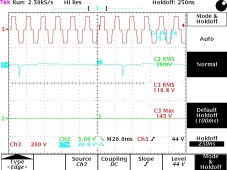
With heater on "low", AC current resembles AC waveform, and is 5.44Arms.
Battery current is 54.7App ripple on scope, 64Arms on clamp meter.
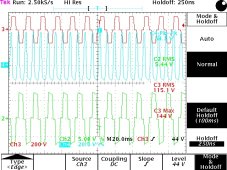
Heater on "medium", AC current is 6.44 Arms.
Battery current waveform is 22.1 App, riding on 77 Arms per clamp.
Scope reading of current appears lower for "medium" than for "low" because switching power supply is now in "continuous conduction mode", a sawtooth waveform that doesn't drop all the way to zero. Because probe is AC not DC, scope doesn't reflect the offset that clamp ammeter shows.

Heater on high, AC current 10.67A
Battery current 40.2 App riding on 124Arms.
That's about 164A high, 84A low.
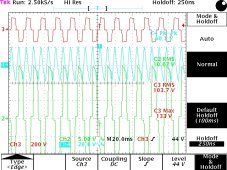
The instantaneous peak battery current of 164A is 1/3 higher than the 124A RMS average current reported by clamp ammeter. This was powering 1300W load with a high-frequency inverter that has pretty good set of electrolytic capacitors.
Would expect similar current for a 48V battery inverter powering 5200W.
But this was with a worn-out AGM battery being discharged at 3C relative to its remaining capacity.
If a fresh lithium battery, would expect voltage to hold up better so more ripple current from battery.
This could give some insight to how a BMS might react.
About 25 years ago I found myself with idle hands and some money ($800?) burning a hole in my pocket. I wandered into Quement Electronics in San Jose and walked out with a StatPower PROwatt 2500W inverter (12V battery to 120VAC modified square wave.)

The guts include a bank of transistors and transformers

Instrumented with a DENT current transformer (333 mV/100A) on AC output,
Fluke i2000FLEX 200A, 2000A Rogowski Coil on battery cable (10 Hz to 20 kHz response)

SunXtender 104Ah 12V AGM battery (14 years old, about 40% capacity remaining)

Test Results
| Battery Amps (per Ames clamp) | VDC nominal | W(DC) | AC Irms (per Fluke i2000) | V | W | Efficiency | |
| Off | 0.5 | 12.7 | 6.35 | 0.03 | 120 | 3.6 | |
| Low | 64 | 11.5 | 736 | 5.44 | 120 | 652.8 | 89% |
| Medium | 77 | 11.4 | 873.95 | 6.44 | 120 | 772.8 | 88% |
| High | 124 | 10.8 | 1333 | 10.67 | 120 | 1280.4 | 96% |
120 | |||||||
| "C" rate | 3.0 | discharge on high, vs. remaining battery capacity |
The efficiency figure for no-load is bogus, reflects a 30 mA AC draw that is probably zero-offset error in the scope.
At the "high" setting of DeLongi radiator heater, it was giving low-battery alarm. Might not have done that with a new battery, but this one is in poor shape.
| TDS 784D | Tek scope |
| P5210A | Tek high voltage probe |
| i2000FLEX | Fluke 200/2000A probe (Rogowski Coil) |
| CT-S-SC-0100 | DENT 100A current transformer (with resistor, 333mV = 100A) |
| 77III | Fluke DMM |
| CM1000A | Ames (Harbor Freight) clamp DC ammeter (Hall effect) |
The waveforms are where it gets interesting.
With heater switched off, inverter sucks a 15.6A gulp of current from battery once every 7 cycles. Clamp ammeter reported 0.5Arms (which isn't the correct average to compute power from DC battery; need mean)
The Modified Square Wave AC output has a dead-time at zero volts and plateau of +/-145V. DMM reads 120 Vrms.

With heater on "low", AC current resembles AC waveform, and is 5.44Arms.
Battery current is 54.7App ripple on scope, 64Arms on clamp meter.

Heater on "medium", AC current is 6.44 Arms.
Battery current waveform is 22.1 App, riding on 77 Arms per clamp.
Scope reading of current appears lower for "medium" than for "low" because switching power supply is now in "continuous conduction mode", a sawtooth waveform that doesn't drop all the way to zero. Because probe is AC not DC, scope doesn't reflect the offset that clamp ammeter shows.

Heater on high, AC current 10.67A
Battery current 40.2 App riding on 124Arms.
That's about 164A high, 84A low.

The instantaneous peak battery current of 164A is 1/3 higher than the 124A RMS average current reported by clamp ammeter. This was powering 1300W load with a high-frequency inverter that has pretty good set of electrolytic capacitors.
Would expect similar current for a 48V battery inverter powering 5200W.
But this was with a worn-out AGM battery being discharged at 3C relative to its remaining capacity.
If a fresh lithium battery, would expect voltage to hold up better so more ripple current from battery.




